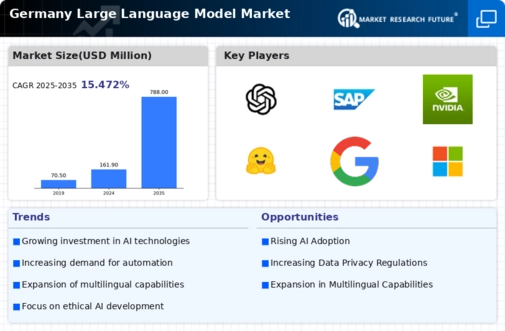Rising Demand for Automation
The large language-model market in Germany is experiencing a notable surge in demand for automation across various sectors. Businesses are increasingly recognizing the potential of language models to streamline operations, enhance productivity, and reduce costs. In 2025, it is estimated that the automation market in Germany could reach €10 billion, with a significant portion attributed to the integration of large language models. This trend is driven by the need for efficient customer service solutions, automated content generation, and data analysis. As organizations seek to optimize their workflows, the large language-model market is likely to play a pivotal role in facilitating these advancements. This will reshape the operational landscape..
Focus on Data Privacy and Security
In the context of the large language-model market, data privacy and security have emerged as paramount concerns for businesses in Germany. With stringent regulations such as the General Data Protection Regulation (GDPR) in place, companies are compelled to ensure that their AI solutions comply with these standards. This focus on data protection is likely to influence the development of language models, as organizations seek to implement robust security measures. In 2025, it is estimated that investments in data security solutions will increase by 20%, reflecting the growing emphasis on safeguarding sensitive information. As a result, the large language-model market may evolve to prioritize privacy-centric features, thereby enhancing trust and adoption.
Government Initiatives and Funding
The German government is actively promoting the development and adoption of artificial intelligence technologies, including large language models. Initiatives aimed at fostering innovation and research in AI are gaining momentum, with funding allocations reaching approximately €1 billion in 2025. These efforts are designed to position Germany as a leader in AI technology, encouraging collaboration between academia and industry. The large language-model market stands to benefit significantly from these government initiatives, as they provide the necessary resources and support for research and development. This environment is conducive to the growth of the market, potentially leading to breakthroughs in language processing capabilities.
Integration with Emerging Technologies
The convergence of large language models with emerging technologies such as machine learning, natural language processing, and cloud computing is reshaping the technological landscape in Germany. This integration is expected to enhance the capabilities of language models, making them more efficient and versatile. In 2025, the market for cloud-based AI solutions is anticipated to grow by 25%, with a substantial portion driven by advancements in large language models. As organizations increasingly adopt these integrated solutions, the large language-model market is poised for significant growth, potentially leading to innovative applications across various industries.
Growing Interest in Multilingual Capabilities
Germany's diverse linguistic landscape is driving a growing interest in multilingual capabilities within the large language-model market. As businesses expand their operations internationally, the need for language models that can understand and generate content in multiple languages becomes increasingly critical. In 2025, it is projected that the demand for multilingual language models will account for over 30% of the total market share in Germany. This trend reflects the necessity for companies to engage effectively with diverse customer bases, thereby enhancing their competitive edge. Consequently, the large language-model market is likely to evolve to meet these multilingual demands, fostering inclusivity and accessibility.



















Leave a Comment